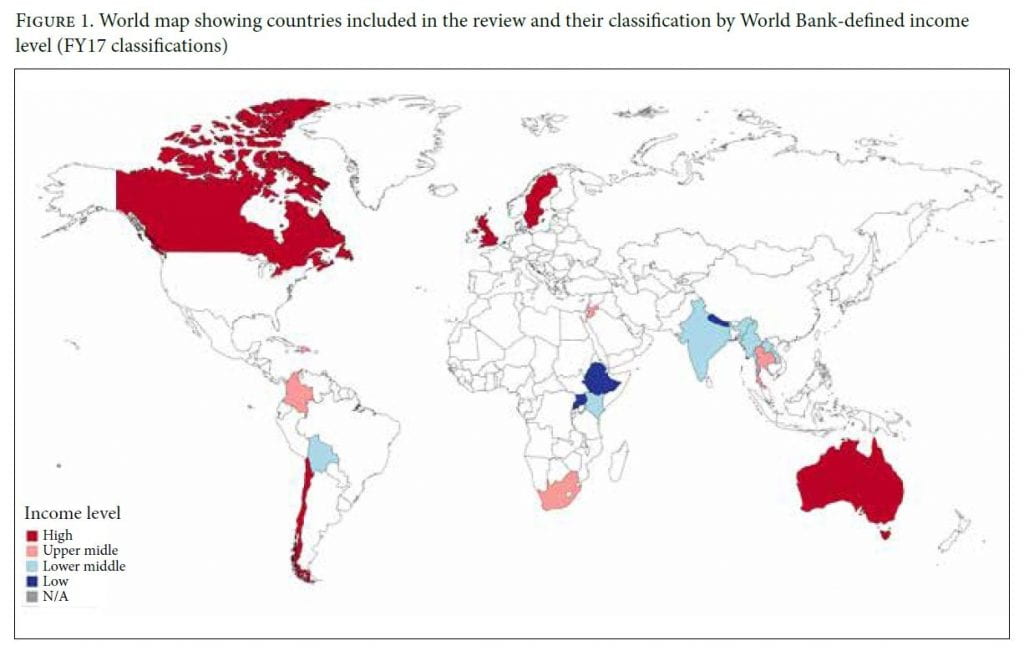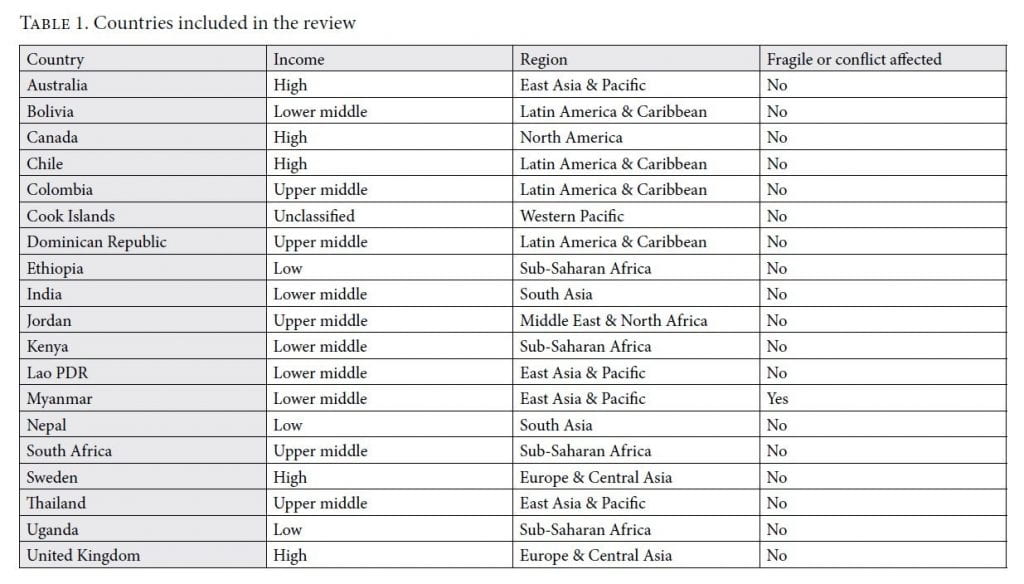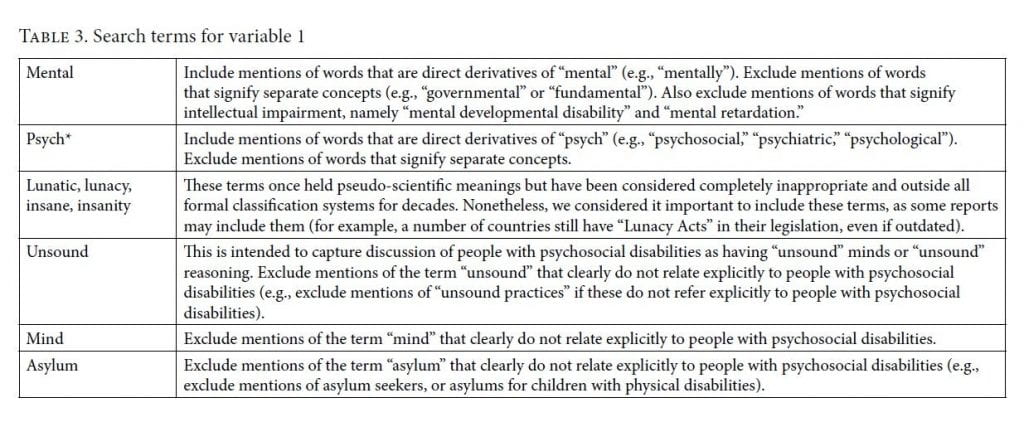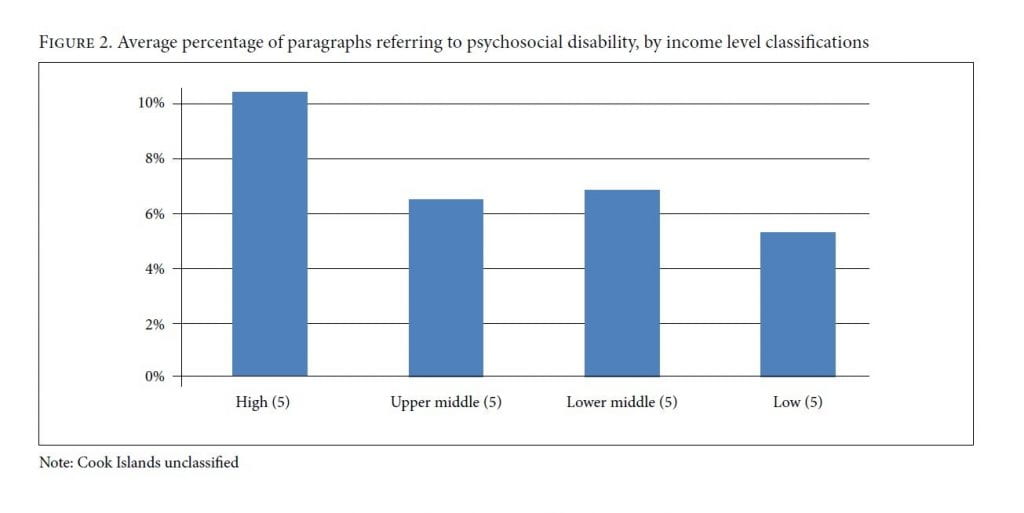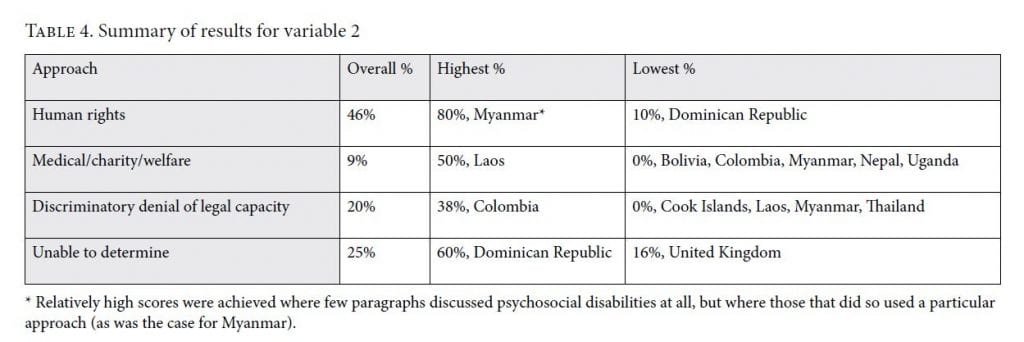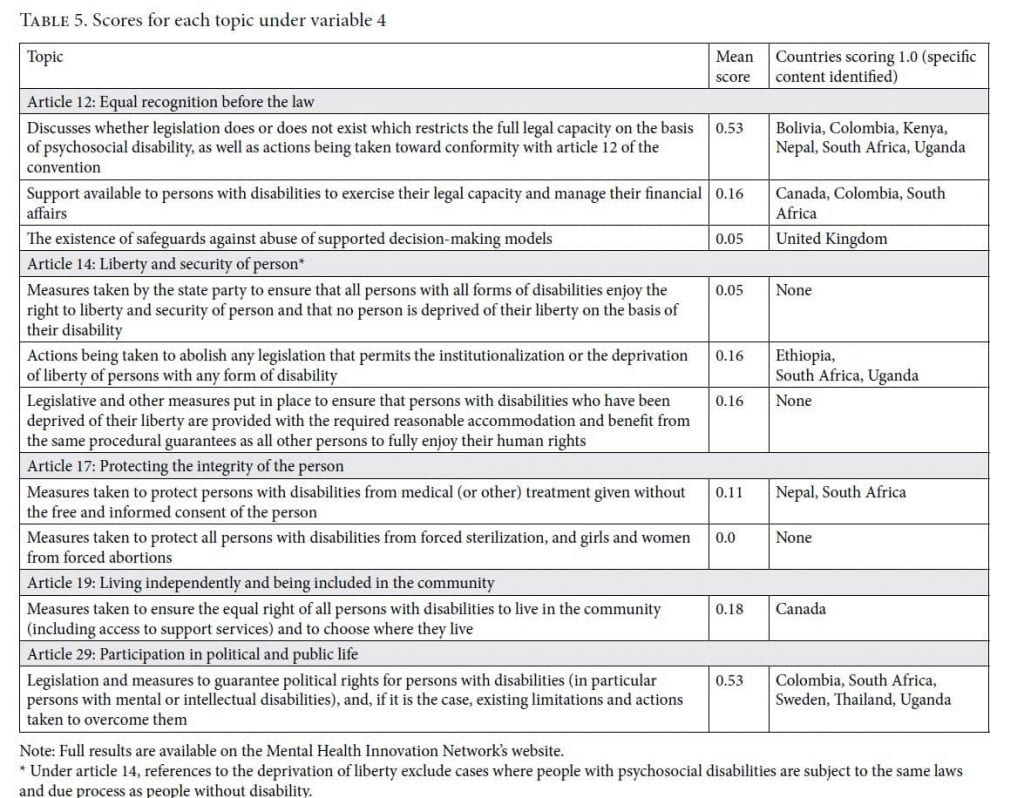Accountability for the Rights of People with Psychosocial Disabilities: An Assessment of Country Reports for the Convention on the Rights of Persons with Disabilities
Volume 23/1, June 2021, pp. 175-189
Julian Eaton, Aleisha Carroll, Nathaniel Scherer, Lucy Daniel, Michael Njenga, Charlene Sunkel, Kirsty Thompson, Diane Kingston, Gulshan Ara Khanom, and Sean Dryer
Abstract
The Convention on the Rights of Persons with Disabilities (CRPD) has been identified as a milestone in human rights protection, offering people with psychosocial disabilities the opportunity to hold their governments accountable for the realization of their rights. To facilitate such accountability, the country reports produced under the CRPD reporting process should adequately reflect these persons’ experiences and relevant positive or negative developments in the country. Our study used content analysis to review the extent and quality of reporting related to mental health and psychosocial disabilities in 19 country reports. The criteria used were based on provisions of the CRPD and on priorities identified by a steering committee of people with psychosocial disabilities. We found a wide variation in the quantity and quality of states’ reporting, with an indication that this variation relates to countries’ economic development. Increasing the participation of representative organizations of people with psychosocial disabilities is needed for state parties to fulfill their reporting obligations. While there has been progress in improving organizations of persons with disabilities capacity to be heard at the global level, our findings suggest low levels of participation in CRPD processes at the national level in many countries. State parties must actively include these groups to ensure implementation of the CRPD principles.
Introduction
Around the world, people with mental conditions and associated psychosocial disabilities are among the most marginalized groups in society.1 Psychosocial disabilities are those disabilities that arise from barriers to social participation experienced by people who have or who are perceived to have mental conditions or problems, and the term is now widely used within the disability movement.2 While the form and extent of exclusion and abuse may differ from culture to culture, the problem is “near universal.”3 Since coming into force in 2008, the United Nations (UN) Convention on the Rights of Persons with Disabilities (CRPD) has been heralded as marking a paradigm shift in the way that disability is understood and responded to.4 It moves away from the traditional perspective of persons with disabilities as “objects” of charity in need of “cure,” to a human rights perspective that addresses the barriers experienced by people with psychosocial disabilities across all life domains.5 This is the realization that people with disabilities are rights holders, who must be afforded agency to make their own decisions and to participate, on an equal basis with others, as active members of society.6 In addition, a systematic review in 2016 found that consultations with mental health service users in policy formulation processes increased the likelihood of improved mental health services and outcomes.7 The CRPD provides a clear articulation of the human rights of people with psychosocial disabilities in line with other impairment groups, and was drafted with the involvement of their representative organizations.8
The accountability mechanisms for monitoring and reviewing states’ implementation of the CRPD are detailed in the UN Disability Inclusion Strategy.9 The Optional Protocol to the CRPD includes further mechanisms for remedies and redress.10 The Committee on the Rights of Persons with Disabilities (CRPD Committee), an independent “committee of experts”—also known as a human rights treaty body—conducts a constructive dialogue with countries that have ratified the treaty (state parties). Initially, countries must submit a report two years after formal ratification of the treaty, and then periodically every four years, outlining their progress in the realization of disability rights in domestic law, policy, and practice. Persons with disabilities are expected to be full participants in this process—based on clear recommendations in the CRPD Committee’s General Comment 7, which includes a discussion of articles 4(3) and 33(3) concerning the meaningful participation of people with disabilities in decision-making and in providing input into national reporting by state parties.11 Civil society organizations and national human rights institutions are encouraged to submit parallel, or “shadow,” reports during the state’s drafting process. Other aspects of this process also encourage meaningful participation—for example, the review of the country report by national human rights institutions must include the expectation of participation and must be attuned to the priorities of people with psychosocial disabilities as identified by their representative organizations.12
A member of the CRPD Committee volunteers to lead the report review and drafts a “list of issues” to be addressed by the country in its response. This “list of issues” is a list of themes or questions formulated by the treaty body on the basis of a state party’s report and other available information (for example, information supplied by UN specialized agencies, national human rights institutions, civil society organizations, and other contributors), which is transmitted to the country government in advance of the session at which the treaty body will consider the country report. The list of issues provides the framework for a constructive dialogue with the government delegation. A good general understanding among actors in the process is essential if these issues are to be properly addressed in the “constructive dialogue” on the report at the CRPD Committee meeting.
Civil society organizations can access the committee’s concluding observations or recommendations issued to a government after the constructive dialogue. The concluding observations or recommendations provide civil society with another mechanism to hold state parties accountable. In this way, civil society organizations can contact the Secretariat of the CRPD Committee and draw the committee’s attention to inaction on the part of state parties. The CRPD Committee also has its own follow-up procedure whereby a dedicated member of the committee tracks the actions that state parties are undertaking or failing to undertake.13
Despite these formal procedures, throughout the world, it is unclear whether people with psychosocial disabilities are fully benefiting from the potential of the CRPD accountability mechanisms when it comes to the realization of their rights. There are a number of reasons why this may be the case. First, while at the global level national organizations of persons with psychosocial disabilities have been very influential, not least in the CRPD development process, these organizations may be newly formed or emerging, financially vulnerable, or nonexistent at the national level in many countries, particularly in lower-income countries.14 Second, where such organizations do exist at the national level, there are barriers to their participation in the preparation of country reports, given that based on prejudice and exclusion, there is often no formal role for them to contribute to decision-making processes such as policy development. Such exclusion can also come from within the disability community itself, meaning that persons with psychosocial disabilities may be underrepresented in national disability federations. This exclusion undoubtedly results in members of organizations lacking the opportunity to advocate effectively as part of the reporting process.15
The aim of this research is to empirically assess these assumed limitations by measuring how psychosocial disabilities have been included in the reports submitted by state parties to date. By better understanding the content of these reports, it will be possible to gain insight into the inclusion of people with psychosocial disabilities in national policies and programs, as well as the success of their representative organizations in using the CRPD Committee as a mechanism to hold duty-bearers, including governments and the private sector, to account. We hope that these insights into the country reporting process will elucidate disparities in participation in the CRPD accountability process at the national level and inform the strengthening of this process going forward.
Methods
We reviewed 19 states parties’ official reports submitted to the CRPD Committee to ascertain the quantity and quality of content related to psychosocial disabilities. These reports were purposively selected for representation across global regions and income levels (low-, lower-middle-, -upper middle-, and high-income countries using World Bank criteria) to ensure that a diverse range of national experiences were captured.
Overall, the review included three countries classified as low income, five of each other classification, and one unclassified (Figure 1). The East Asia and the Pacific region, the Latin America and the Caribbean region, and the Sub-Saharan Africa region were the most represented, at four countries each. Myanmar was the only country included that is classified under “fragile and conflict-affected situations” by the World Bank. Table 1 includes a list of the countries reviewed and their detailed classifications.
A review of the relevant literature did not identify an appropriate tool for analyzing the content of such reports. We therefore developed a framework for assessing the variables considered to be particularly pertinent to reporting on the realization of rights of persons with psychosocial disabilities and used content analysis of the reports’ text to review them.16
At the start of the research, we established a steering committee to inform the process and guide decisions at various stages. This committee was made up of people who have personal experience living with psychosocial disabilities and working in this field, some of whom had participated in CRPD reporting processes, and who come from a range of countries, including those in our study.
The steering committee (which included all of this paper’s authors) developed, by consensus, five variables for judging the strengths of the country reports with respect to psychosocial disabilities. These variables were based on CRPD principles, common errors in understanding psychosocial disabilities, and priorities identified by organizations of people with psychosocial disabilities in the literature.
Variable 1: The extent of discussion in the report regarding psychosocial disability
Variable 2: Theoretical approaches informing the report’s discussion of psychosocial disability
Variable 3: The extent to which the report distinguishes psychosocial disability from intellectual disability
Variable 4: The extent to which the report addresses CRPD articles considered highly relevant to people with psychosocial disabilities
Variable 5: The extent to which the report’s discussion of accessibility initiatives (such as reasonable accommodation) addresses psychosocial disabilities compared to other disability types
This framework was developed into a psychosocial disability rights content analysis tool (PDR-CAT), establishing a coding guide for each variable, which we used to analyze the country reports and assign scores for the reports against each variable. The tool and coding guidance are available on the Mental Health Innovation Network’s website. This process was repeated by a second independent reviewer using the same tool. We assessed inter-rater reliability using the Cohen’s Kappa method.17 Where there were discrepancies between the raters, reasons for this were discussed by the researchers and the steering committee to decide on clearer coding guidance to remove ambiguity, and with a view toward better reflecting the intended purpose of the variable. We then recoded the relevant variables according to these decisions. In addition, there is much detail in the reports that cannot be captured in dichotomous variables, even where some intermediate scores were used. Thus, throughout the results, we have included notes that attempt to describe these nuances. More details for each variable, along with the reconciled coding and notes of these additional details, are presented below.
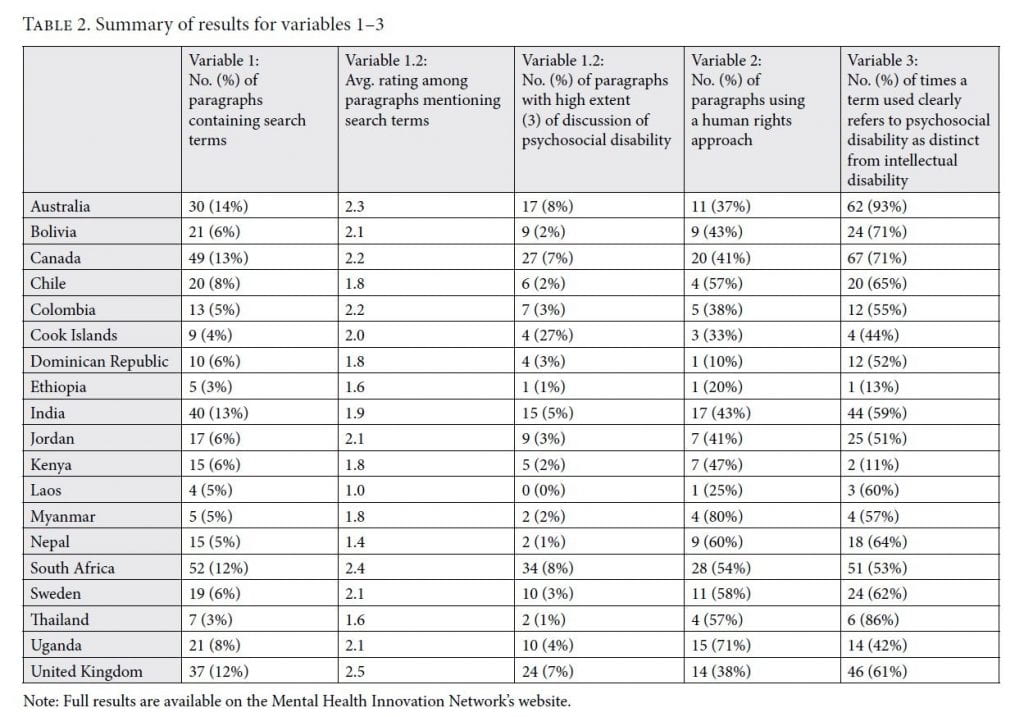
Results
Variable 1: The extent of discussion regarding psychosocial disability
Variable 1 measured the extent of each report’s discussion of psychosocial disability. We carried out a word search to identify paragraphs including “search terms” related to psychosocial disability (Table 3), which we identified through a literature review and review of a sample of country reports. We excluded paragraphs if they included the search terms but clearly did not refer to psychosocial disability. We then calculated the proportion of paragraphs in each report that included the search terms (see Figure 2).
Of the 19 country reports assessed, the total report lengths ranged between 88 paragraphs (Laos) and 426 paragraphs (South Africa), with a median of 265 paragraphs (Uganda). The percentage of paragraphs discussing psychosocial disability ranged between 3.3% (Thailand) and 13.9% (Australia), with a median of 5.6% (Nepal) (Table 2). Following recoding for differences, Cohen’s Kappa for the inclusion/exclusion of paragraphs as discussing psychosocial disability was 0.91, “almost perfect” according to the guidelines proposed by J. Richard Landis and Charles Koch. While we cannot comment on the proportion of paragraphs deemed to be a good amount—as we would not expect to have specific impairment groups mentioned in some paragraphs—what is clear is that there is a wide variation among countries. In addition, the average proportion of paragraphs discussing psychosocial disabilities was twice as high in high-income countries compared to low-income ones (Figure 2).
Variable 1.2: The extent to which psychosocial disability is discussed in each paragraph
Variable 1.2 measured the extent to which psychosocial disability was discussed in each paragraph based on a set criteria and ordinal scale (1=low, 2=moderate, 3=high extent). The extent may be rated higher either because the search terms appeared in a large proportion of the paragraph’s sentences or because one or more sentences focused on issues relevant to psychosocial disability in particular (as opposed to disability in general). These data inform several considerations:
- The total rating of all paragraphs mentioning the search terms, to give an overall summary of the amount of discussion of psychosocial disability in the report.
- The average rating among those paragraphs mentioning the search terms, to give a sense of the extent to which the discussion of psychosocial disability in the report focused specifically on psychosocial disability compared to including it in broader discussion.
- The average rating among all paragraphs, with paragraphs not mentioning the search terms rated as zero. This provides a composite between variables 1 and 1.2, providing an overall summary of the degree to which the report focused on psychosocial disability relative to other topics.
Key findings by country are given in Table 2. Of the 19 country reports assessed, the total scores for reports ranged between 4 (Laos) and 127 (South Africa), with a median of 36 (Chile). It should be noted that this is influenced in part by the overall length of the report (the South African report was long overall). The average score for paragraphs including search terms was 2.1, reflecting a range between 1.0 (Laos) and 2.5 (United Kingdom). The average score among all paragraphs was 0.16, reflecting a range between 0.05 (Thailand, Laos, Ethiopia) and 0.32 (Australia). Notably, the report from Laos was the only report with no paragraphs with a high extent of discussion of psychosocial disability. Weighted Cohen’s Kappa was 0.57, rated as “moderate” according to the guidelines proposed by Landis and Koch. The relatively low agreement is due to the multiple pathways by which scores are assigned and by a decision by the steering committee to clarify the criteria after coding had been done, at which point the first coder was not available to recode. (See “Strengths and weaknesses” below.)
Variable 2: Theoretical approaches informing the discussion of psychosocial disability
Variable 2 assessed the theoretical approaches informing each report’s understanding of psychosocial disability, rating each paragraph that mentioned psychosocial disability according to one of four categories based on recognized models and ways of thinking about disability: (1) human rights approach; (2) medical/charity/welfare approach; (3) discriminatory denial of legal capacity; and (4) unable to determine. The percentage of paragraphs in a report that took each approach serves as an indicator of the report’s theoretical approach, and not any underlying policies it describes. Thus, a paragraph that described a discriminatory policy, but criticized it, was rated “human rights approach.” Cohen’s Kappa was 0.61, rated as “substantial.” Reduction in concordance was driven mostly by the tool stating that where a country report’s frame was both “discriminatory denial of legal capacity” and “medical/charity/welfare approach,” then the overarching approach subsumed the “discriminatory denial,” causing some confusion. In general, this highlights that there was little disagreement as to whether the “human rights” approach was taken.
Findings for countries’ use of the “human rights” approach are presented in Table 2. A summary of findings for variable 2 is presented in Table 4.
Variable 3: The extent to which psychosocial disability is distinguished from intellectual disability
The degree to which each country report made a clear distinction between intellectual and psychosocial disability might be judged to be a sign of depth of understanding among the report writers. Confusion between these two types of disabilities is fairly common, though it should be noted that the CRPD does not itself provide a definition. We assessed each individual mention of a search term and coded whether the term clearly referred to psychosocial disability or possibly included intellectual disability. A list of classifications is provided in the guidance, indicating whether a given term indicates one or the other; however, coders could classify terms based on their judgment as to whether the rest of the paragraph gave greater clarity.
Findings are shown in Table 2. Across all reports, 61% of all relevant terms used clearly distinguished psychosocial disability from intellectual disability. Australia had the highest percentage (93%), while Kenya had the lowest percentage (11%). Cohen’s Kappa (following a reconciliation after a coding clarification) was 0.83, “almost perfect” under Landis and Koch’s guidelines.
Variable 4: The extent to which CRPD articles considered highly relevant to people with psychosocial disabilities are discussed
Certain articles in the CRPD (12, 14, 17, 19, and 29) are considered to be highly relevant to people with psychosocial disabilities (as determined by the steering committee and the priorities of people with psychosocial disabilities identified in the literature). Where specific content for one of these articles was identified in the country report, we scored the report “yes” (1.0) for that article. If the phrasing in regard to the article was not consistent with the priorities of people with psychosocial disabilities, then we gave a score of “no” (0). Reports were rated 1.0 only if they described the issue specifically for people with psychosocial disabilities, as opposed to people with disabilities in general.
“Yes” ratings were rare for most topics. Following the initial round of coding, we modified this variable to allow for a score of 0.5 for articles with multiple criteria in which a report discussed some of those criteria but not all of them. We made this change to make the variable more sensitive, as initial ratings were extremely low. A summary of scores is presented in Table 5.
Out of a possible 10 points across all topics, South Africa had the highest total (5.5), while the Dominican Republic and Laos had the lowest (0.5). The median total score was 1.5—in other words, very low. Notably, no report discussed measures taken to protect all persons with disabilities from forced sterilization and girls and women from forced or coerced abortions or contraception. The initial Cohen’s Kappa for the entire data set (that is, analyzing all of the content pieces together) was 0.63, rated as “substantial” according to Landis and Koch’s guidelines. After we recognized that all criteria for a “yes” were hard to meet, we introduced the 0.5 score and then recoded all reports using the new system.
Variable 5: The extent to which the discussion of accessibility initiatives addresses psychosocial disabilities compared to other disability types
While issues related to accessibility and reasonable accommodations are generally well understood for people with physical and sensory disabilities, the means of addressing exclusion in psychosocial disabilities are often not well understood or even considered. We therefore examined discussion of article 9 in each country report to explore reported initiatives to address accessibility and reasonable accommodation in relation to psychosocial disability compared to other disabilities. We used criteria to review this section of each report in full and identify any accessibility initiatives, coding each as “physical,” “vision,” “deaf or hard of hearing,” “intellectual,” “intellectual/psychosocial (unclear),” “psychosocial,” “other impairments,” or “unable to determine.”
Our findings are shown in Figure 3. There was a dramatic lack of initiatives for psychosocial disabilities compared to every other group identified, except for intellectual disability. Across all reports, physical, vision, and deaf or hard of hearing had 71, 35, and 28 initiatives identified, respectively, compared to 0 for psychosocial disability and 2 for intellectual/psychosocial. The overall findings of the two coders were nearly identical. Due to the nature of coding this section, Cohen’s Kappa could not be calculated on a pairwise comparison of specific initiatives and was instead calculated at the country level at 0.63, rated as “substantial” according to Landis and Koch’s guidelines. This excludes “unable to determine,” which was much less consistent, but not considered important to the findings.
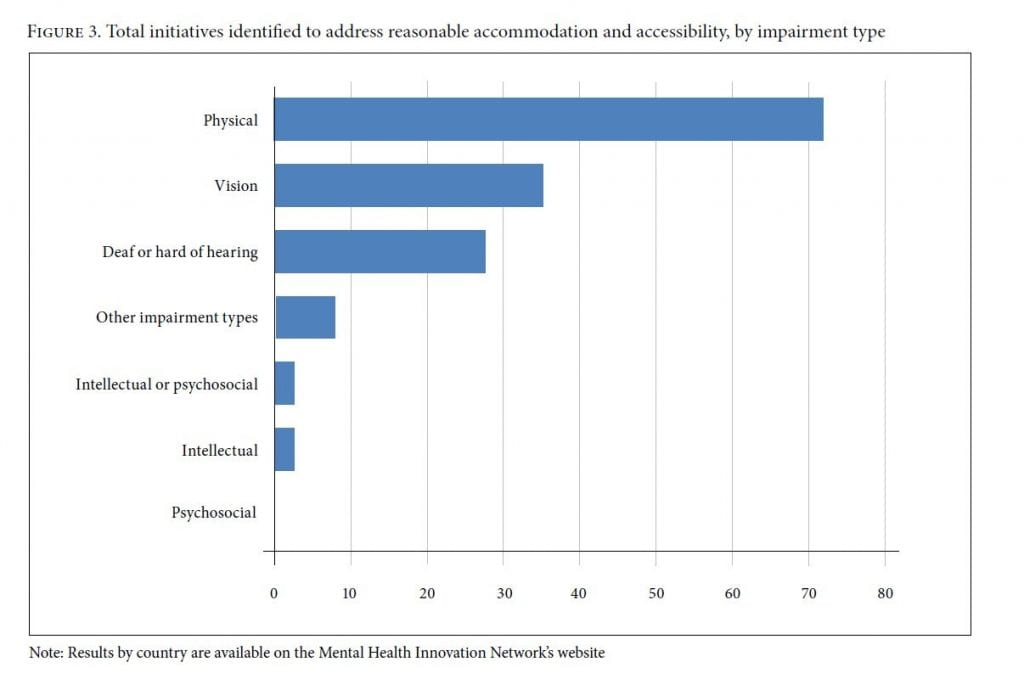
Discussion
There is substantial variability in the extent to which country reports discussed psychosocial disability (demonstrated by variable 1). Using the composite score, Australia’s score of 0.32 indicates more than six times the proportion of discussion dedicated to psychosocial disability compared to Thailand, Laos, or Ethiopia. In gross terms, South Africa devoted more than 10 times as many paragraphs as Myanmar, Ethiopia, or Laos.
While some of this variation may be attributed to the length of each report in general, it could also be an indication of the wide variety of prioritization of psychosocial disability in countries’ national disability agenda, as well as governments’ competence and confidence in reporting on this issue.
An additional consideration is the tendency for more and better focus on psychosocial disability when relevant people were included in the writing process of the report, as stipulated in article 35(4) of the CRPD. People with psychosocial disabilities may not have been part of the writing group in all countries. Even where their input was invited, governments’ decision whether to include their submissions in the final draft was ultimately outside the control of people with psychosocial disabilities. This was also reflected in the experience of our steering committee, whose members felt that where organizations of people with psychosocial disabilities were included from the start, their issues were covered better and more prominently.
The wide variation in the extent to which countries reported specifically on psychosocial disability—as opposed to integrating it into wider disability issues—should be taken into context. For example, the United Kingdom’s high score on specific mention of psychosocial disability is in general a good thing (as a neglected area needs to be highlighted), but the state fell short in considering psychosocial disability across all life domains beyond health—for example, in relation to housing, education, community life, and so forth—and alongside other types of disability. Where reports discuss states’ performance on disability in general, it is important for psychosocial disability to also be included, and not only in special sections (for example, by focusing only on specific rights like consent or access to mental health services). We believe that this would be reflected by a higher proportion of paragraphs including our search terms (variable 1) than the median of 5.6% found in this sample.
Variable 2 demonstrates that nearly half of the paragraphs discussing psychosocial disability appeared to use a theoretical approach grounded in human rights, although charity, medical, and discriminatory approaches were used in almost all country reports. This may be a reflection of levels of knowledge and attitudes about different models and approaches to disability in general rather than psychosocial disability in particular, which we would expect to be high among those writing the reports. That being said, in many countries (such as Australia, India, and South Africa), psychosocial disability and intellectual disabilities are treated distinctly from other types of disability, particularly in relation to autonomy and in relation to will and preference in decision-making, including for medical treatment. As noted in Australia’s report:
Consent to medical treatment is regulated by policies and/or legislation in each jurisdiction. Australia considers that the Convention allows for compulsory assistance or treatment of persons, including measures taken for the treatment of mental illness, where such treatment is necessary as a last resort and subject to safeguards.18
With the introduction of the CRPD, the International Classification of Functioning, Disability and Health, and other disability models and frameworks, global actors are moving away from traditional medical and charity models. However, there needs to be a recognition that this process is more difficult for countries with limited resources or different cultural attitudes and beliefs. Such countries may need additional support, especially when cultivating cultural responsiveness toward and acceptability of a global movement.
Based on variable 3, it is clear that many country reports did not make a distinction between psychosocial and intellectual disability, although this varied substantially between countries. In some cases, this approach may be appropriate (such as mentions of “physical and mental disabilities”), and in other cases, it is difficult to determine whether it reflects a poor use of language or an underlying failure to distinguish the two in practice, especially for countries where English is not a national language. Examples of ambiguous and derogatory language include “mental disability,” “mentally challenged,” “unsound mind,” and “mentally deranged.” For such high-level reports to not be clear about the distinction implies a poor level of understanding among the authors. We would suggest that knowledge of the distinction between psychosocial and intellectual disabilities—and of the nuances of neurological (for example, migraine), behavioral (for example, autism or attention deficit disorder), and cognitive (for example, dementia) conditions—is essential for authors of CRPD country reports.
It is clear from variable 4 that country reports did not describe policies ensuring the prioritization of the rights of persons with psychosocial disabilities. By extension, this could mean that organizations of people with psychosocial disabilities are facing barriers to advocacy efforts in national CRPD accountability mechanisms. Further research is required to elucidate the experiences of people with psychosocial disabilities and their organizations when engaging with CRPD report-writing processes. National-specific assessment would need to be done to verify this in each case. Variable 5 strongly indicates that state parties are not implementing, or at least reporting, reasonable accommodations and accessibility initiatives for persons with psychosocial disabilities (or intellectual disabilities). This is one variable where a direct comparison with other disabilities was possible, and it is clear that there is a dramatic gap in progress for psychosocial disability compared with other areas of disability.
Our findings indicate that there is, in general, a poor level of reporting about psychosocial disabilities in country reports to the CRPD Committee. While there is need for further research to understand what the reasons for this might be, it is clear that states’ reporting capacity needs to be addressed. This requires that national reporting processes better engage with people with psychosocial disabilities and their representative groups, empowering their input and advocacy. The results of our research may be a useful tool for the CRPD Committee, relevant UN agencies (particularly members of the UN Partnership on the Rights of Persons with Disabilities), and civil society groups seeking to advocate more effectively for a greater focus on rights-based approaches to psychosocial (and intellectual) disabilities in policy, and in CRPD reporting in particular.
Strengths and weaknesses
Content analysis proved a valuable way to objectively assess the content of the country reports for volume and quality of content related to psychosocial disability and to reveal disparities in the representation of different disabilities. The variables that were included in our tool were derived from a consensus among a group identified as experts and experienced in the field, with backgrounds in policy, the UN system, academia, and service user movements. We feel that these allow the reports’ quality to be judged by how well they address issues that are relevant to psychosocial disabilities. What is harder to examine is the underlying reasons behind our findings. This question of the “why” would be best addressed through additional qualitative research. It would also be useful to analyze country reports in the context of shadow reports (where they exist). Although shadow reports may have no impact on a country’s report, the representation of psychosocial disability in these shadow reports may indicate the level of participation of people with psychosocial disabilities in national disability movements, thus helping target capacity-building interventions. In addition, a review of subsequent country reports from the same countries could be used to gauge whether there is a trend of improvement in this area.
Our sampling frame was purposive, so we were able to compare results across, for example, income levels of countries, but we cannot claim that the countries chosen were representative of these income levels or that the political and policy environments are consistent across these countries.
The use of our tool raised some complex questions of interpretation, even though agreement was achieved between the independent reviewers. For example, Myanmar used the human rights approach in almost all cases where it mentioned psychosocial disabilities, meaning that it scored highly, despite mentioning such disabilities infrequently and without detail. The United Kingdom tended to write specifically about psychosocial disabilities in particular areas but did not address psychosocial disability across all life domains. While we feel we achieved a fair level of agreement about interpretation, there would be benefit to updating guidance for the tool for future use. There was great value in having a steering committee to guide the nuanced discussions that often arose, anchoring the final decisions in core approaches that we wished to reflect in the establishment of the criteria for the analysis. Inevitably, any element of change raises questions of replicability and consistency of method, requiring reflection in interpretation. The tool also relies on identifying relevant paragraphs through the use of a set of keywords associated with psychosocial disability, which may not be exhaustive. Some generic paragraphs not mentioning our search terms may theoretically be referring to psychosocial disabilities.
Variable 5 was our only variable that analyzed data for other disability types, and for this variable the difference was stark. However, while representation of psychosocial disability may appear low in other variables, we are unable to measure this against other types of disability. A version of the tool adapted for one or more other types of disability would allow this comparison in future analysis. In addition, this may highlight how strong the reports were for other disabilities and whether those that were weaker for psychosocial disabilities were also weaker overall.
Conclusion
There is considerable variability in the quality of states’ reporting on psychosocial disabilities when following CRPD accountability processes, despite broad recognition of the importance of the full and meaningful participation of people with psychosocial disabilities.19 We found a lower quality of reporting on psychosocial disabilities in low-income countries in particular, which may reflect the effects that limited resources have on reinforcing prejudicial social norms or a lack of exposure to contemporary debates around psychosocial disability in relation to CRPD compliance. While this research did not include information on the extent to which people with psychosocial disabilities participated in the reporting process, we recommend that the first step in addressing disparities in reporting be to improve engagement with representative organizations of people with psychosocial disabilities. International and national agencies working with government bodies can engage with government focal points to promote a more receptive environment for civil society participation.
Hand in hand with this recommendation is the recognition that meaningful engagement will require the empowerment of people with psychosocial disabilities by providing sufficient resourcing for existing and emerging organizations and building the capacity of national umbrella organizations. In all countries, organizations of people with disabilities would benefit from increased knowledge of UN reporting processes and the extent to which they should be included in reporting mechanisms. Though the evidence on what works to promote the leadership of people with psychosocial disabilities in low- and middle-income countries is still relatively limited, there are examples of success.20 These examples usually point to organizations and movements with strong governance structures and clear values.21 Integral to the realization of the rights enshrined in the CRPD for people with psychosocial disabilities is building their capacity and strengthening their voices at the national level, and improving their representation at the global level, so as to exploit fully CRPD processes for meaningful participation of people with disabilities.22
It is perhaps most helpful to use equivalence with other forms of disability as the best benchmark for expectations of levels of participation and quality of reporting. By this measure, there are particular gaps in understanding and reporting around reasonable accommodation and accessibility for persons with psychosocial disabilities. Specific efforts need to be made to improve understandings and attitudes around mental health and psychosocial disabilities. Epilepsy South Africa has developed good guidelines that could be used as an example for making similar information available for psychosocial disabilities.23 There also exist accessible online resources that could be adapted for use in other countries.24 In all areas of disability practice and research, attention should be paid to ensuring that this historically neglected area is now able to make full use of this essential global mechanism for accountability for the rights of people with disabilities. More broadly, strengthening procedures for the meaningful participation of people with disabilities is likely to lead to improved accountability for their rights at the national and international level.
Julian Eaton, MBBS, MRCPsych, is the Mental Health Director at CBM Global and an Assistant Professor at the London School of Hygiene and Tropical Medicine, UK.
Aleisha Carroll, BAppSc, MPH, is the Manager of the Inclusion Advisory Group at CBM Australia, Melbourne, Australia.
Nathaniel Scherer, BSc, MSc, is a Research Assistant at the International Centre for Evidence in Disability in the Faculty of Infectious Tropical Diseases, London School of Hygiene and Tropical Medicine, UK.
Lucy Daniel, MSc, is an Advisor to the Inclusion Advisory Group at CBM Australia, Melbourne, Australia.
Michael Njenga is Head of Programs at USP Kenya, Nairobi, Kenya.
Charlene Sunkel, is the Founder/CEO of the Global Mental Health Peer Network, Johannesburg, South Africa.
Kirsty Thompson, BAppSc, PhD, is the Director of the Inclusion Advisory Group at CBM Global Disability Inclusion and an Honorary Academic, Faculty of Medicine, Dentistry and Health Sciences at the University of Melbourne, Australia.
Diane Kingston OBE, BA, MSc, is the Global Technical Lead on Disability Inclusion and Mainstreaming at Sightsavers, Chippenham, UK.
Gulshan Ara Khanom, MBBS MPH, is a research volunteer at the Nossal Institute for Global Health, Melbourne, Australia.
Sean Dryer, MSc, is an independent global health consultant associated with the Globally Minded Foundation, Bulgaria.
Please address correspondence to Julian Eaton. Email: julian.eaton@lshtm.ac.uk.
Competing interests: None declared.
Copyright © 2021 Eaton et al. This is an open access article distributed under the terms of the Creative Commons Attribution Non-Commercial License (http://creativecommons.org/licenses/by-nc/4.0/), which permits unrestricted noncommercial use, distribution, and reproduction.
References
1 A. E. Yamin and E. Rosenthal, “Out of the shadows: Using human rights approaches to secure dignity and well-being for people with mental disabilities,” PLoS Medicine 2/4 (2005).
2 Human Rights Council, Report of the Special Rapporteur on the Right of Everyone to the Enjoyment of the Highest Attainable Standard of Physical and Mental Health, Dainius Pūras, UN Doc. A/HRC/29/33 (2017).
3 A. Wilson and A. S. Daar, “A survey of international legal instruments to examine their effectiveness in improving global health and in realizing health rights,” Journal of Law, Medicine and Ethics 4/1 (2013), pp. 89–102.
4 Human Rights Council, Report of the Special Rapporteur on the Rights of Persons with Disabilities, UN Doc. A/HRC/31/62 (2016).
5 J. Eaton, “A human rights-based approach to mental health legislation and global mental health,” BJPsych International 16/2 (2019), pp. 37–41.
6 J. K. Burns, “Mental health and inequity: A human rights approach to inequality, discrimination, and mental disability,” Health and Human Rights Journal 11/2 (2009), pp. 19–31.
7 M. Semrau, A. Alem, L. Abdulmalik, et al., “Developing capacity-building activities for mental health system strengthening in low- and middle-income countries for service users and caregivers, service planners, and researchers,” Epidemiology and Psychiatric Sciences 27 (2018), pp. 11–21.
8 World Network of Users and Survivors of Psychiatry, Implementation manual for the United Nations Convention on the Rights of Persons with Disabilities (Odense: World Network of Users and Survivors of Psychiatry, 2008).
9 UN General Assembly, United Nations disability inclusion strategy (UNDIS). Available at https://www.un.org/en/content/disabilitystrategy/assets/documentation/UN_Disability_Inclusion_Strategy_english.pdf.
10 Committee on the Rights of Persons with Disabilities, Fact Sheet on the Procedure for Submitting Communications to the Committee on the Rights of Persons with Disabilities under the Optional Protocol to the Convention, UN Doc. CRPD/C/5/2/Rev.1 (2012).
11 Committee on the Rights of Persons with Disabilities, General Comment No. 7: Participation of Persons with Disabilities in the Implementation and Monitoring of the Convention, UN Doc. CRPD/C/GC/7 (2018).
12 Committee on the Rights of Persons with Disabilities, Guidelines on Periodic Reporting to the Committee on the Rights of Persons with Disabilities, including under the Simplified Reporting Procedures, UN Doc. CRPD/C/3 (2016).
13 Committee on the Rights of Persons with Disabilities, Follow-up to Concluding Observations on State Party Reports, UN Doc. CRPD/C/19/3 (2018).
14 World Health Organization, Mental health atlas 2014 (Geneva: World Health Organization, 2014).
15 A. Carroll, B. Davar, J. Eaton et al., “Inclusion of people with psychosocial disability in development research and programming,” Development Bulletin 77 (2016), pp. 30–34.
16 K. Neuendorf, The content analysis guidebook (Thousand Oaks: Sage Publications, 2002).
17 J. R. Landis and G. G. Koch, “The measurement of observer agreement for categorical data,” Journal of Biometrics 33/1 (1977), pp. 159–174.
18 Implementation of the Convention on the Rights of Persons with Disabilities, Initial Reports Submitted by States Parties under Article 35 of the Convention: Australia, UN Doc. CRPD/C/AUS/1 (2012).
19 A. Sweeney and J. Wallcraft, Quality assurance/monitoring of mental health services by service users and carers (WHO Regional Office for Europe, 2010).
20 R. Price, “Strengthening participation of people with disabilities in leadership roles in developing countries,” K4D Helpdesk Report, Institute for Development Studies (2018). Available at https://assets.publishing.service.gov.uk/media/5b18fd1440f0b634c0c590d7/Strengthening_participation_of_people_with_disabilities_in_leadership_roles.pdf.
21 M. O’Hagan, “Leadership for empowerment and equality: A proposed model for mental health user/survivor leadership,” Journal of Leadership in Public Services 5/4 (2009).
22 Committee on the Rights of Persons with Disabilities, General Comment No. 7 (see note 10).
23 T. Merrill, Reasonable accommodation guidelines: An instructional guide to reasonable accommodation for people with epilepsy (Cape Town: Epilepsy South Africa, 2017).
24 Reimagine, Disability and psychosocial disability. Available at https://reimagine.today/step-1/disability-and-psychosocial-disability.


